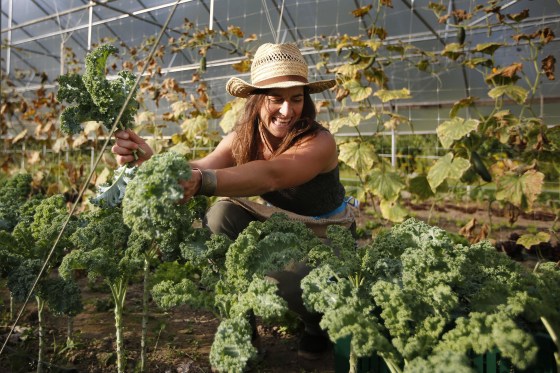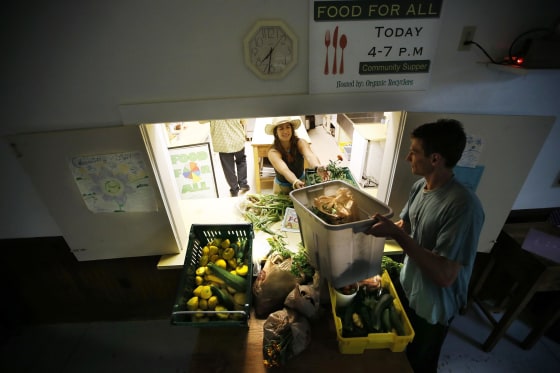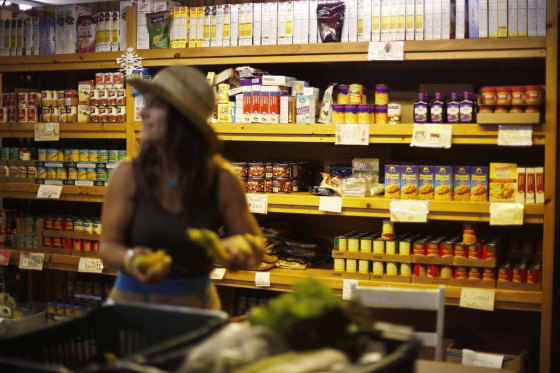From: NBC News
SEDGWICK, Maine- For years, Winnifred Gomm, known as “Ma,” drove to the local community radio station here in Hancock County to air a segment called Ma’s Kitchen. She’d offer tips on best kitchen practices and present “good recipes that people can make pretty easy with ingredients nearby.”
Now 84, Gomm has struggled to follow her own advice. She lives on about $7,000 a year in Social Security, and buying healthy food can be a challenge. “I’ve been a busy, working person most of my life, but I am actually very poor,” Gomm says in a dense Maine accent. “The kind of food I was used to buying, that is expensive.”
Yet recently things have changed for Gomm. Greens and hearty root vegetables now occupy her refrigerator, thanks to a local initiative that gathers excess crops from small farms — a process called gleaning — and delivers them to food pantries and food distribution programs for low-income families and individuals like her. With the help of volunteers, local health advocacy organization Healthy Acadia gleans 30,000 pounds of food each year, taking crops that would otherwise go to the pigs to people in need. It’s one of dozens of similar programs nationwide.
On a recent Thursday morning, dressed in work boots and flannel, Hannah Semler, the coordinator or Healthy Acadia’s gleaning initiative, drove out of Blue Hill, a few miles from Gomm’s town of Sedgwick, and up the long incline to the King Hill farm. King Hill owners Amanda Provencher and Paul Schultz, a couple in their 30s, wake every morning before the sun to prepare for long days working the fields of greens, corn, and berries, milking the cows, fighting the beetles from the greenhouses, and restringing the tomato plants.
With two kids and what seems like an unyielding chase to keep the tractors, wood splitters, chain saws, and tillers in working order, they’re like most of America’s small farmers. “Time for us is the most valuable resource; we don’t have any extra,” says Schultz, as he stands beside one of his greenhouses filled with a bumper crop of tomatoes in the height of the season’s bounty.
And because they’re so busy, Provencher and Schultz welcome Hannah Semler and her volunteers to their farm every week. “We just don’t have time to pick everything we grow, so we’d just till it right back into the soil or feed it to the animals, but it’s still totally good food,” Schultz says. “Hannah is identifying a resource that we have that otherwise we just would not be utilized because there are not enough hours in the day.”
 Robert F. Bukaty / for NBC News
Robert F. Bukaty / for NBC NewsSemler crouched down on a row of lettuce and kale and with a small knife cut from just above the roots, packing three bins with the leafy greens. The three boxes she fills that day are just a portion of the nearly 800 pounds of vegetables she gleans from King Hill farm each year. Semler does the same thing at 18 other farms in and around Mount Desert Island and Blue Hill, in coastal Hancock County, a place with some of the most striking inequality in the state: vast rural poverty beside luxurious summer homes and boutique back to the earthers.
From the farm, she drives the vegetables to the Tree of Life Food Pantry in Blue Hill, one of 18 pantries and other “food security sites” where the project delivers gleaned crops. Tree of Life is where Gomm picks up a box of food every Thursday for her vegetables. It provides canned goods, meat, eggs and vegetables to nearly 200 families from eight nearby towns each week; 1,000 families a year. In Sedgwick, where Gomm lives, 27 percent of residents rely on the pantry at some point in the year, nearly twice the national average of food insecure families.
“The food that Hannah brings from the gleaning project, that’s some of the best stuff the people who come here take home,” Rick Traub, the president of Tree of Life said as Semler carried in three overflowing crates of deep green salad and kale. “It’s a small amount, but for those who take home a bunch of greens, it’s literally the only thing like that they’ll eat all week.”
 Robert F. Bukaty / for NBC News
Robert F. Bukaty / for NBC NewsNationally, 15 percent of Americans are food insecure, which means that they did not have enough healthy sustaining food at all times, according to U.S. Department of Agriculture. A recently released report from Feeding America, the largest domestic hunger relief organization, found that most of the households who request help from the organizations’ network of 46,000 food agencies report making the hard choice between spending their scarce resources on food and paying the utility bill, buying gas, getting medical care or paying rent. The dilemma leads poor families to buy cheaper, less nutritious food.
“Many people are stuck with terribly hard choices,” said Ross Fraser, the media director for Feeding America. “They know they are choosing less nutritious food, but they have to pay for basics like rent and other expenses where there’s no flexibility.”
And in the face of growing needs, many pantries are reduced to offering whatever is donated, supplying families with calories rather than healthy meals. Gleaning initiatives help to raise the quality of this free food.
The Feeding America report also found that 65 percent of households who request help for the organizations’ network of 46,000 food agencies, said that they’re facing food insecurity because they were out of work, most often because of retirement or disability.
“If you’re poor when you’re working, you’ll be poor when you retire,” said Gomm, who worked in a textile mill and held half a dozen other jobs over the years.
Many hungry families who come to Tree of Life need help even though the adults in the family are working.
“Poverty here is everywhere,” Traub says. “I go to the grocery store and the person who cashes me out, I see her the next day at the pantry. The problem of hunger in the U.S. has very little to do with a scarcity of food. There’s far more food available around here than people to eat it. The problem is really about access.”
 Robert F. Bukaty / for NBC News
Robert F. Bukaty / for NBC NewsNationally, gleaning efforts have become a major part of the way that food pantries gather nutritious food to provide to those who otherwise would not have access to it.
The Society of St. Andrew, the largest gleaning group in the U.S., harvests or gathers 30 million pounds of food each year to distribute to a network of pantries. The effort barely scratches the surface. More than 100 billion pounds of food goes uneaten at the consumer level each year in the U.S., according to the U.S.D.A., and according to some estimates, close to around 40 percent of crops ready for harvest never make it to American tables.
To encourage more sharing of food that would go to waste, federal and state lawmakers have created tax breaks for donating to farms and grocery stores. In 1996, Congress passed a law protecting farms from liability if food donated to a nonprofit later makes a person sick. These national efforts often involve large farms and grocery stores, offloading tens of thousands of pounds of produce or other food before it spoils.
Locally, the Healthy Acadia initiative is following a similar if smaller model, but its food is consistently fresh, and the project creates a local network of farms, food pantries and families. About half of the food that Semler gleans goes not to food banks but to the Magic Food Bus, a project of the Healthy Peninsula, which partners with Semler’s group. The bus, which is really a car or van, delivers fresh food to drop spots like schools and apartment complexes for elderly residents. “Together, we’re trying to make healthy food accessible and normal as possible,” Semler says.
“So often, people have no idea where their food comes from, they just eat it and are detached from the process,” says Semler. “But we’re getting food from the local farms that these folks drive by everyday. They know the farms and now they eat from them.”
First published August 20th 2014, 5:52 am

